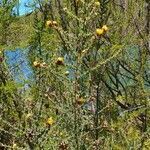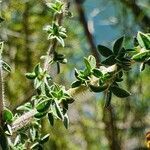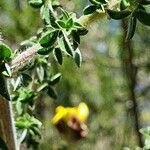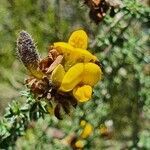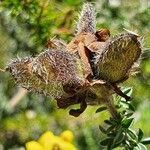Leaves petiolate; leaflets elliptic or ovate-lanceolate, occasionally lanceolate, subacute to round and apiculate at the apex, cuneate to obtuse at the base, sparsely to very densely covered with golden-brown appressed or ± spreading hairs above and beneath, more densely so beneath; terminal leaflet usually 3–6 (very rarely only 2.5–3) times as long as the petiole, 23–51(60) × 10–18(26) mm; petioles mostly 6–16 mm long but in the lowermost leaves sometimes up to 30(40) mm long; stipules 5–12 × 2–6 mm, ovate to ovate-lanceolate, sometimes cordate, acuminate, free or united only at the base, occasionally one of the pair bifid, persistent or very late caducous.
Corolla bright yellow, sometimes the petals becoming orange or reddish with age; standard 10–13 × 8–10 mm, widely obovate to subcircular, undulate at the margins, densely silky pubescent outside; wings c. 11 × 2.5–3 mm, oblong and sometimes slightly curved, narrowed at base into a c. 2 mm long claw, with rows of folds between the upper veins, glabrous or sometimes with brown hairs near the apex outside; keel little shorter than the wings, curved, the petals not or only slightly auriculate, with a crest on the lateral surface towards the base and a claw c. 2.5 mm long, glabrous.
Inflorescence terminal or leaf-opposed, racemose and elongate or subumbelliform, racemes 5–20-flowered rarely up to 40-flowered; peduncle 10–80(120) mm long; bracts up to 6 mm long, lanceolate, decreasing and narrowing up the rhachis.
Stems usually more than 2 mm in diameter at the base, densely covered with appressed or ± spreading silvery-grey or golden-brown hairs.
Calyx 8–12 mm long, sericeous; upper lip divided by up to c. three quarters of the calyx length, the lobes oblong-lanceolate.
Bushy woody herb or subshrub 30–70(200) cm high, with several simple or few-branched stems from a woody rootstock.
Pod 30–50 × 4.5–6 mm, narrowly oblong with the valves flat, silky pubescent, c. 12–18-seeded.
Seeds 2.5–3 mm long, oblong-ovoid, dark brown.
